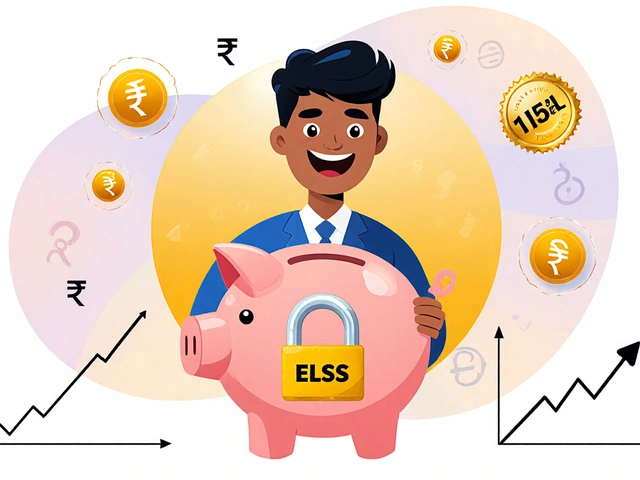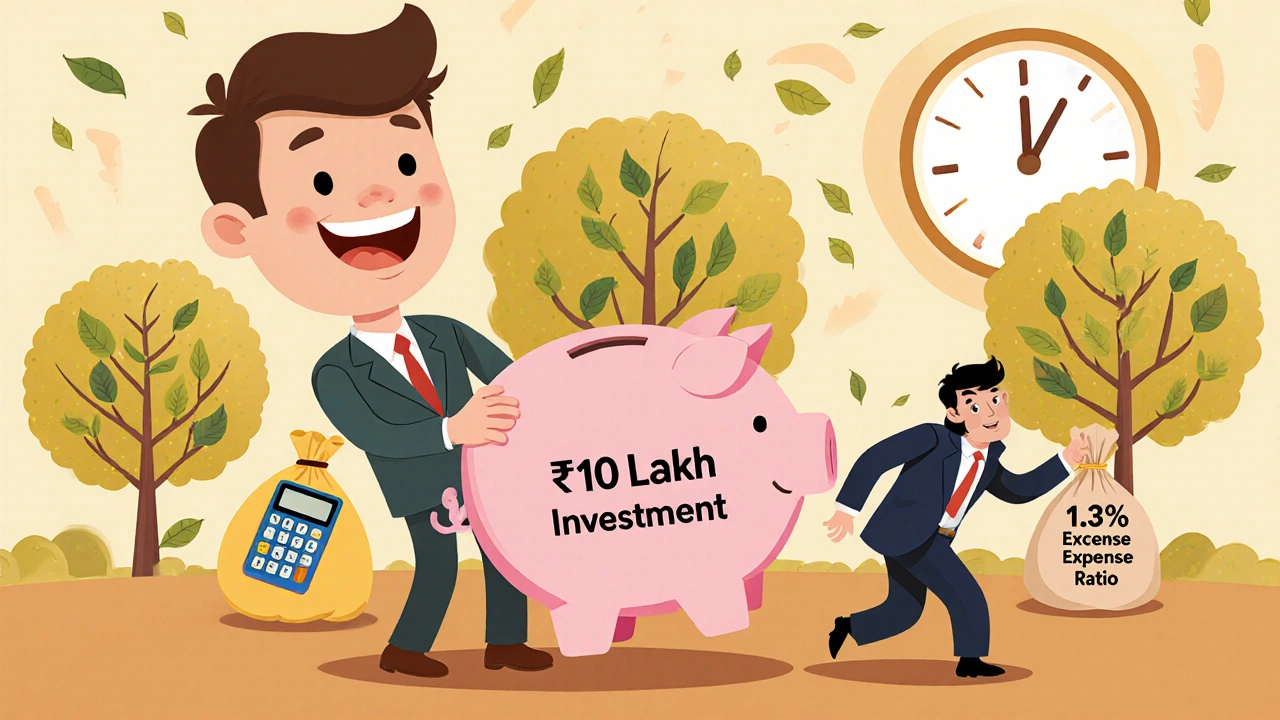Mutual Fund Expense Ratio in India: How Fees Impact Your Long-Term Returns
When you invest in a mutual fund in India, you’re not just paying for the fund manager’s expertise-you’re also paying hidden fees that slowly eat into your returns. These fees are bundled into something called the expense ratio. Most investors don’t realize how much this tiny percentage can cost them over time. A 1% fee might sound small, but over 20 years, it could cost you more than ₹5 lakh in lost gains on a ₹10 lakh investment. That’s not a guess. That’s math.
What Exactly Is an Expense Ratio?
The expense ratio is the annual fee mutual funds charge to cover their operating costs. This includes the fund manager’s salary, administrative expenses, marketing, legal fees, and even the cost of maintaining the fund’s website or customer service hotline. It’s expressed as a percentage of your total investment. If a fund has a 1.2% expense ratio, you pay ₹120 every year for every ₹10,000 you have invested.
These fees are automatically deducted from the fund’s assets, so you never see a bill. That’s the problem. You don’t feel the deduction, but it’s still happening-every single day.
In India, the Securities and Exchange Board of India (SEBI) caps expense ratios based on the fund’s assets. For equity funds, the cap is 2.25% for the first ₹500 crore, then it drops. For debt funds, it’s lower-1.05% for the first ₹500 crore. But even within these limits, there’s a huge difference between a fund charging 0.5% and one charging 2.0%.
How Expense Ratios Kill Long-Term Returns
Let’s say you invest ₹5,000 every month for 25 years in two different equity mutual funds. Both return 12% annually before fees. One has a 0.7% expense ratio. The other charges 2.0%.
After 25 years:
- The 0.7% fund grows to ₹89.6 lakh.
- The 2.0% fund grows to ₹72.1 lakh.
You lost ₹17.5 lakh-just because of fees. That’s enough to buy a car outright, or pay for your child’s college tuition.
The reason? Compounding works both ways. When fees are deducted daily, they reduce the amount of money that can earn returns the next day. Over time, that snowballs. A 1.3% difference in expense ratio can cut your final wealth by nearly 20% over 25 years. That’s not a small detail. It’s the difference between retiring comfortably and having to keep working.
Expense Ratio vs. Exit Load: What You’re Actually Paying
Many investors confuse expense ratio with exit load. They’re not the same.
Exit load is a one-time fee you pay if you withdraw your money before a certain period-usually 1 year for equity funds. It’s a penalty, not a recurring cost. Expense ratio, on the other hand, is a daily tax on your investment, no matter how long you hold it.
Some funds advertise “no exit load” like it’s a perk. But if that same fund has a 2.1% expense ratio, you’re paying far more over time than you would with a 0.5% expense ratio fund that charges a 1% exit load after 1 year.
Always check the expense ratio first. Then check the exit load. The former matters more.

Direct vs. Regular Plans: The Biggest Money-Saver in India
If you’re still investing through a financial advisor or broker, you’re probably in a regular plan. That means the fund pays a commission to the intermediary. That commission comes out of your returns-and it’s baked into the expense ratio.
Switch to a direct plan, and you cut out the middleman. Direct plans have the same underlying portfolio, same fund manager, same risk profile-but an expense ratio that’s 0.5% to 1.5% lower.
For example:
| Fund Name | Regular Plan Expense Ratio | Direct Plan Expense Ratio | Annual Savings |
|---|---|---|---|
| ABC Large Cap Fund | 2.05% | 0.75% | 1.3% |
| XYZ Mid Cap Fund | 2.20% | 0.90% | 1.3% |
| PQR Index Fund | 1.50% | 0.20% | 1.3% |
That 1.3% difference? It’s not just a number. On ₹10 lakh invested, it’s ₹13,000 per year you keep in your pocket. Over 20 years, that’s over ₹4 lakh in extra returns-just by switching plans.
Switching from regular to direct is free. You can do it online through the fund house’s website or platforms like Groww, Zerodha, or Upstox. No paperwork. No penalties. Just better returns.
Index Funds: The Low-Cost Alternative
Why pay 2% for a fund manager to try and beat the market when you can pay 0.1% and match it?
Index funds track a market benchmark like the Nifty 50 or Sensex. They don’t try to pick winners. They just own everything in the index. That means lower trading costs, less research, and almost no human bias.
In India, index funds like the UTI Nifty 50 Index Fund or ICICI Prudential Nifty Next 50 Index Fund have expense ratios below 0.2%. That’s less than one-tenth of what many actively managed funds charge.
Over 20 years, an index fund with a 0.15% expense ratio can outperform an active fund with a 1.8% expense ratio-even if the active fund has slightly higher returns. Why? Because the active fund’s fees eat up the edge.
For most investors, especially beginners, an index fund is the smartest place to start.
What About Performance? Can a High-Fee Fund Justify Itself?
Some advisors argue: “But my fund outperformed the benchmark by 4% last year!”
Here’s the truth: Over 80% of actively managed equity funds in India fail to beat their benchmark over a 5-year period, according to CRISIL data. And that’s after fees.
Even if a fund beats the market for a year or two, it’s rarely consistent. Markets are unpredictable. Fund managers change. Strategies shift. The fee stays the same.
There’s no proven way to predict which active fund will outperform. But there’s a 100% guaranteed way to improve your returns: choose lower-cost funds.

How to Check Your Fund’s Expense Ratio
You don’t need to be a finance expert to find this. Here’s how:
- Go to the fund house’s official website-like SBI, HDFC, or Axis Mutual Fund.
- Search for your fund by name.
- Look for the “Scheme Information Document” or “Fact Sheet.”
- Find the “Expense Ratio” line. It’s usually under “Fees and Charges.”
- Check if it’s a direct or regular plan. If you’re unsure, your broker might be taking a cut.
Or use apps like Value Research, Morningstar, or Moneycontrol. Just type in your fund name, and the expense ratio pops up right away.
If you can’t find it, call the fund house. Ask: “What’s the expense ratio of my fund, and is it a direct or regular plan?”
What’s a Good Expense Ratio in India?
There’s no magic number, but here’s a simple rule:
- Index funds: Aim for 0.1%-0.3%
- Passive or low-turnover funds: Under 0.7%
- Actively managed equity funds: 1.0%-1.5% is acceptable if performance justifies it (rare)
- Avoid anything above 2.0%-especially for equity funds
Debt funds should be cheaper. Anything over 1.2% is high unless it’s a niche fund with special strategies.
Remember: Lower fees don’t mean lower quality. They just mean more of your money stays in your pocket.
Final Advice: Start Here
If you’re just starting out, do this today:
- List all your mutual funds.
- Check their expense ratios using Value Research or the fund house website.
- Identify which ones are regular plans.
- Switch any regular plan with an expense ratio above 1.0% to its direct equivalent.
- For future investments, only use direct plans.
- Consider adding at least one low-cost index fund to your portfolio.
You won’t feel richer tomorrow. But in five years, you’ll have more money. In ten, you’ll have a lot more. In twenty, you’ll wonder why you didn’t do this sooner.
Investing isn’t about picking the next hot fund. It’s about keeping as much of your money as possible. The expense ratio is the quiet thief. Don’t let it steal your future.
Is the expense ratio the only fee I pay in mutual funds?
No, but it’s the biggest one. You might also pay an exit load if you withdraw early, and sometimes a transaction fee when you buy or sell through a platform. But those are one-time or occasional. The expense ratio is charged every single day, year after year, and it’s the main reason your returns shrink over time.
Can I negotiate the expense ratio with my financial advisor?
No. The expense ratio is set by the fund house and approved by SEBI. Your advisor doesn’t control it. What they control is whether you’re in a regular plan (where they get paid) or a direct plan (where you keep the savings). If they push you toward a regular plan, they’re benefiting-not you.
Do I pay expense ratio even if my fund loses money?
Yes. The expense ratio is charged regardless of performance. Even if your fund drops 10% in a year, the fund still takes its percentage. That’s why low fees matter more during downturns-you lose less overall.
How often is the expense ratio updated?
Fund houses update the expense ratio quarterly and publish it in their fact sheets. It can change slightly due to changes in assets under management or operational costs. But major changes are rare. Always check the latest fact sheet before investing.
Should I avoid mutual funds with high expense ratios completely?
Not always-but you need a very strong reason to accept one. If a fund has consistently beaten its benchmark by 3%+ over 10+ years, and its expense ratio is 1.8%, it might be worth considering. But those are rare. For most people, low-cost index funds or direct plans are the better, safer choice.
Next time you review your portfolio, look at the expense ratio first. It’s the one number that never lies-and it’s the easiest fix you can make to grow your wealth faster.




